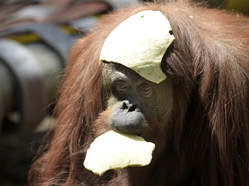|
Adrienne Parsons, PhD '21  In 2015, Sandra was granted freedom from unlawful imprisonment. Having ancestral roots in Sumatra and Borneo, being born in Germany, and being held captive in Argentina, Sandra did not speak the language of her captors and was unable to advocate for herself during her twenty-year confinement. Luckily, a landmark appeals case successfully argued for Sandra’s freedom by invoking her human right of habeas corpus. The catch? Sandra is an orangutan. Sandra’s newfound human status (and the accompanying rights to freedom and protection from harm) is sure to set a precedent for how we identify with and continue to differentiate ourselves from animals. By now, there has been more than sufficient evidence to indicate that many intelligent species have sentience, a sense of identity, and an understanding of social schemas that are not unlike that of humans. Do animals feel empathy? Of course. Elephants have a well-established matriarchal society, and they’ve been shown to mourn the deaths of members of their herd. Are animals capable of learning and understanding through social interaction? Absolutely. Not only have chimps learned to develop tools in the wild, it’s also been shown that they learn how to use them by observing others. When you call a dog by its name, it understands the human social cue to look you in the eyes. Fish can feel pain and the fear of pain interferes with their decision-making [1]. Nonhuman primates have an understanding of fairness and unfairness (see the video below). And even honeybees, a less intelligent species that literally defines the utilitarian concept of “hive minds,” have methods of communication that do not explicitly relate to survival of the colony. (See this absolutely adorable study from earlier this year that discovered that bees say “whoops” when they bump into each other).
 Source: https://thumbpress.com/ Source: https://thumbpress.com/ And as it turns out, some of the more “human” qualities we see in animals are often projections of human thoughts and feelings on animals. For example, studies have shown that dogs do not understand right from wrong in the ways we think they do. While we have all seen countless photos and videos of dogs looking guiltily up at their owners in front of the messes they’ve made or the shoes they’ve chewed up, it’s been established that this is a reaction to the anger expressed, not an understanding of their naughty behavior [2]. Your dog isn’t thinking, “Oh, Mom is really upset that I got into the trash.” He’s thinking, “Mom is yelling and very angry but I have absolutely no idea why.” The perceived differences between animals and humans are not merely in the realm of social order and a sense of self-awareness, either. A long-lasting delineation between humans and animals was the size and complexity of human brains. Neuroscience identifies two branches of comparison: the neurological and the cognitive. Charles Darwin had posited that human brains were simply larger ape brains, and in many ways, this is true. Animals and humans share similar brain structures, with analogous regions associated with the same cognitive functions. Advanced imaging technology, however, has identified both similarities and differences in the cellular makeup and orientation of human brains to those of our close relatives. And while many of the learning capabilities of animals are similar to those of humans on a mechanistic level, very few are as complex and well developed [3]. So where do we draw the line? What, specifically, bestows the right of humanity on an individual? The fact of the matter is that there is no black and white, concrete definition. We can look at social behaviors and form opinions, but how “human” must an animal’s behaviors be in order to cross the threshold? Biology has highlighted similarities between humans and other species, but the lack of complexity in the cellular makeup and cognitive abilities of nonhuman species still sparks debate. This is an area that needs to be explored and these demarcations need to be identified; so much of the success of society depends on our understanding of humans as superior to animals. Animal research is the basis through which we develop life saving technologies to help sick people. Animals produce consumable goods such as silk, wool, and leather. And not everyone is too keen on the idea of going vegan. Until a concrete consensus on the definition of humanity is reached, we’ll still see ourselves at the top of the evolutionary chain. But while we wait for that definition, feel free to wear your title of "Dog Parent" with pride. References:
1. Brown C. Fish intelligence, sentience and ethics. Animal Cognition. 2014Jun19;18(1):1–17. 2. Premack D. Human and animal cognition: Continuity and discontinuity. Proceedings of the National Academy of Sciences. 2007;104(35):13861–7. 3. Horowitz A. Disambiguating the “guilty look”: Salient prompts to a familiar dog behaviour. Behavioural Processes. 2009;81(3):447–52.
0 Comments
Leave a Reply. |
